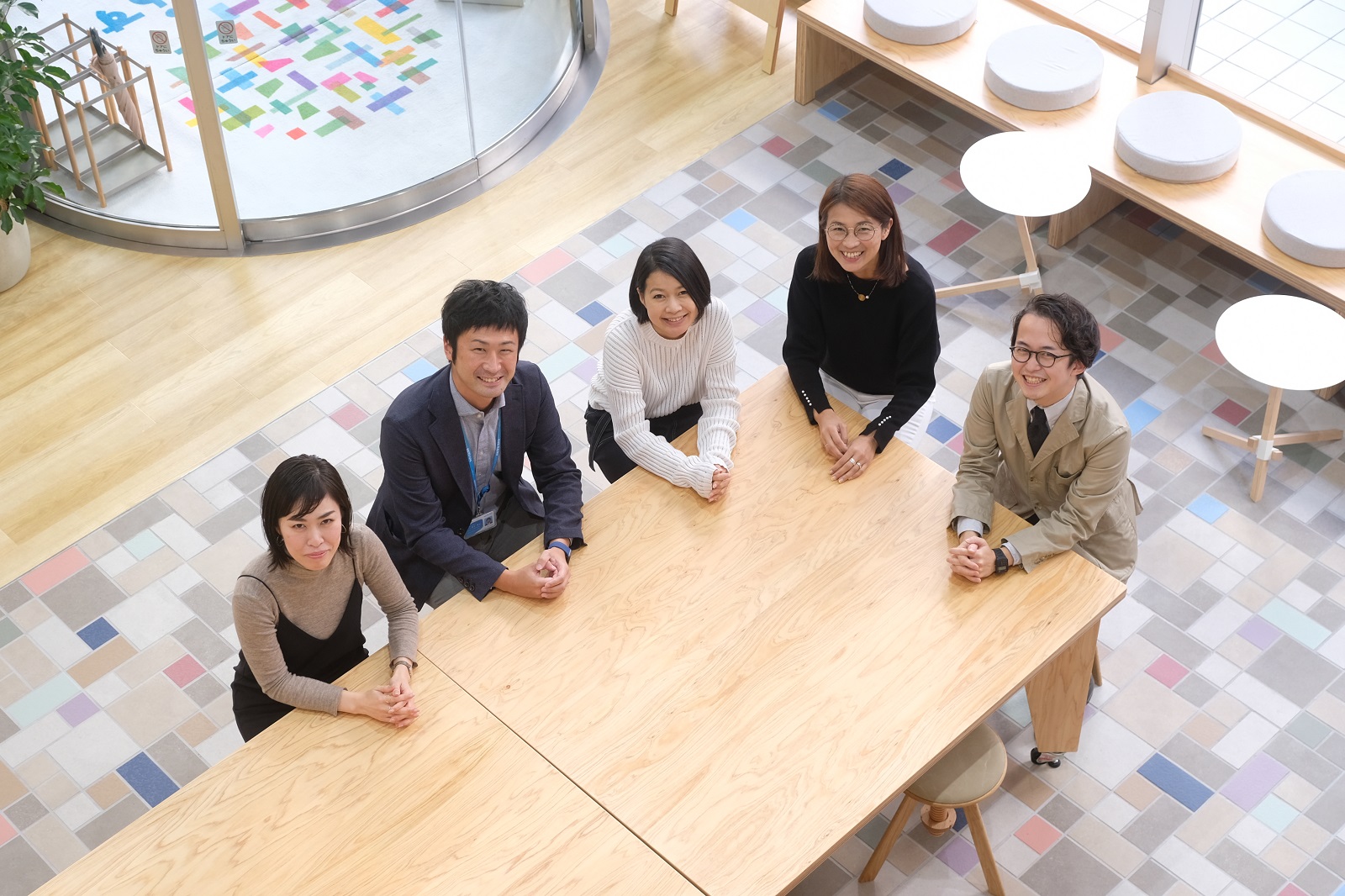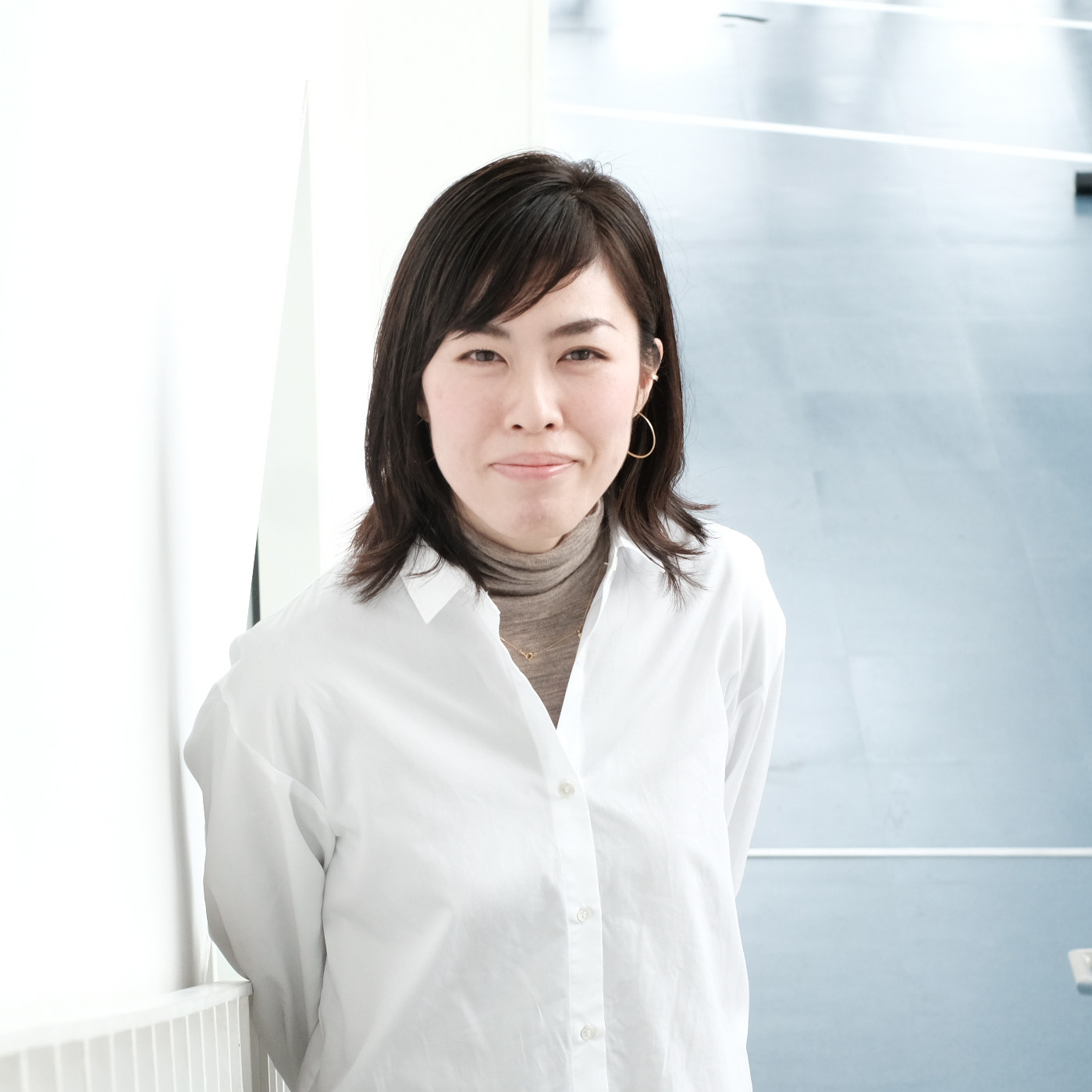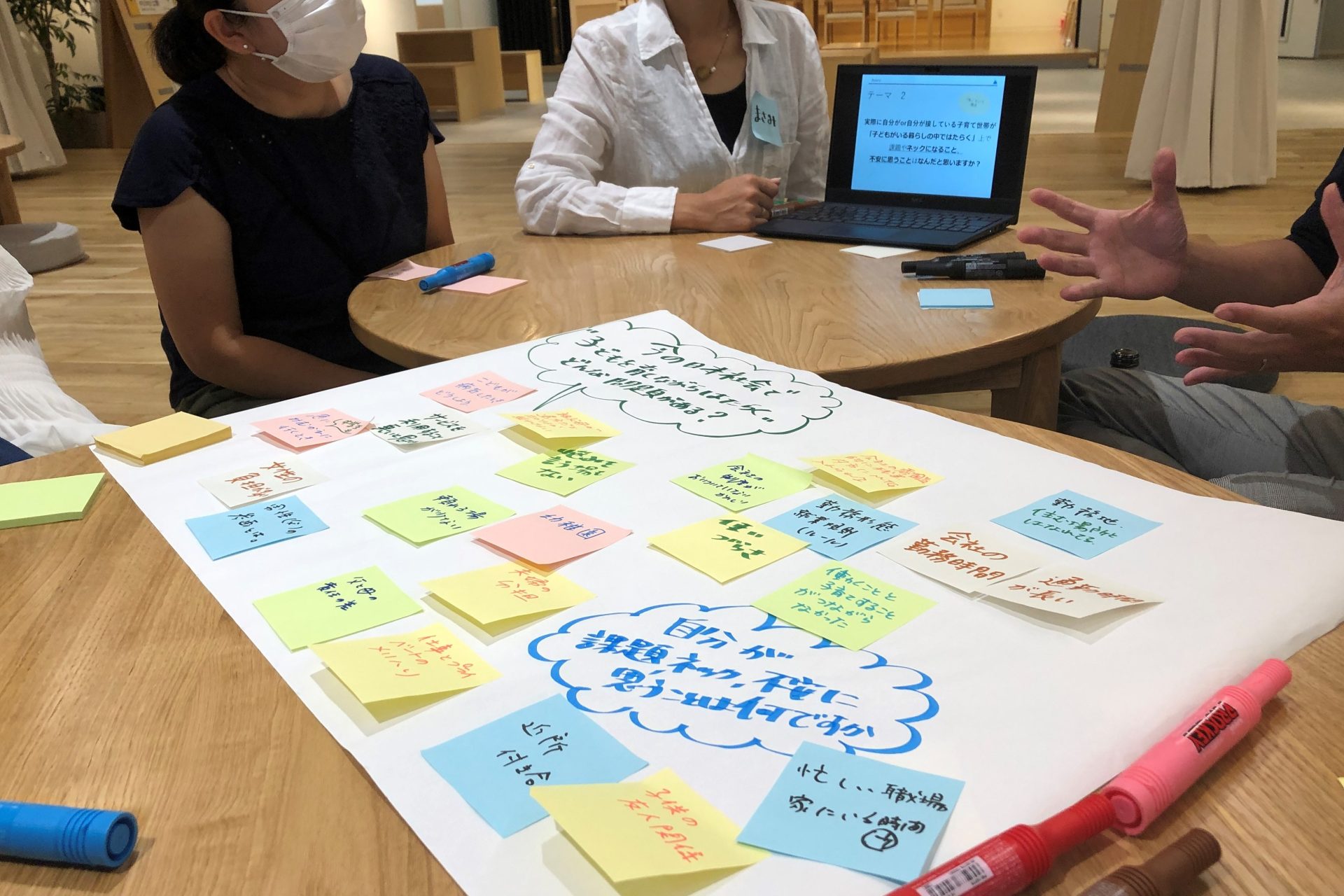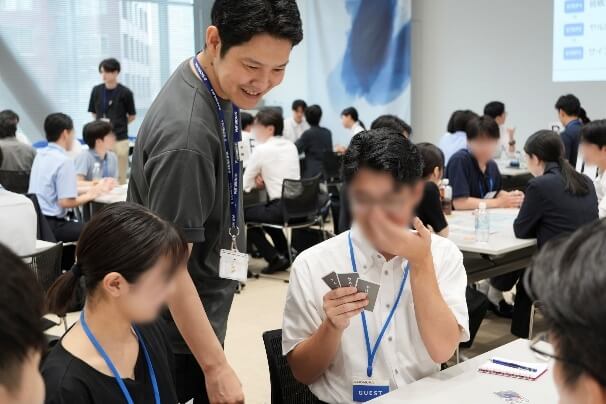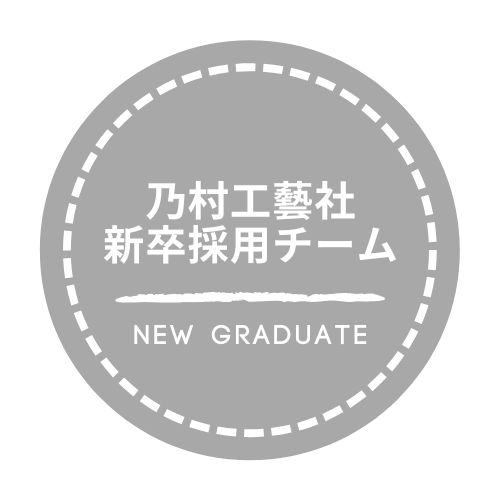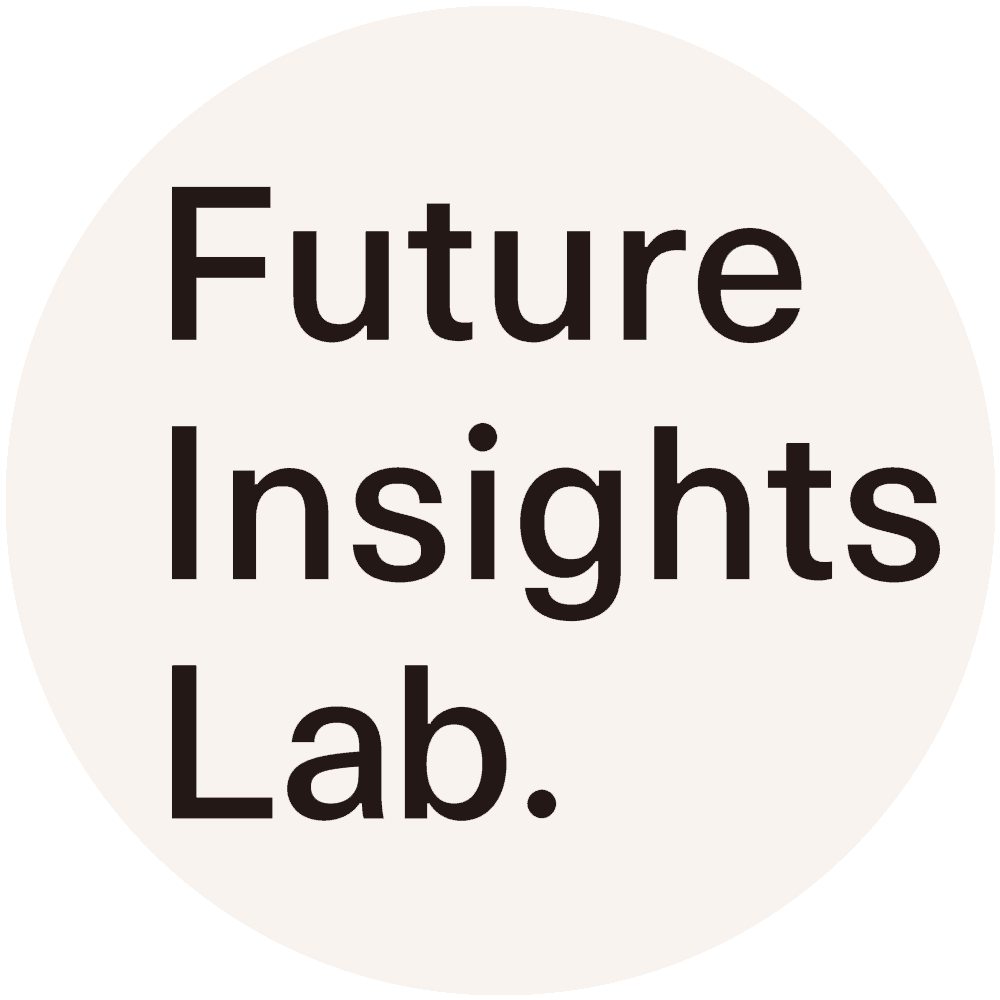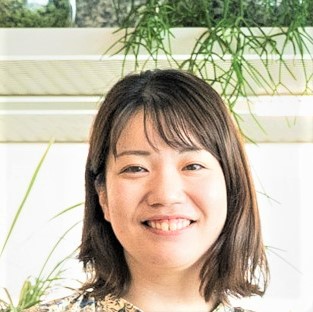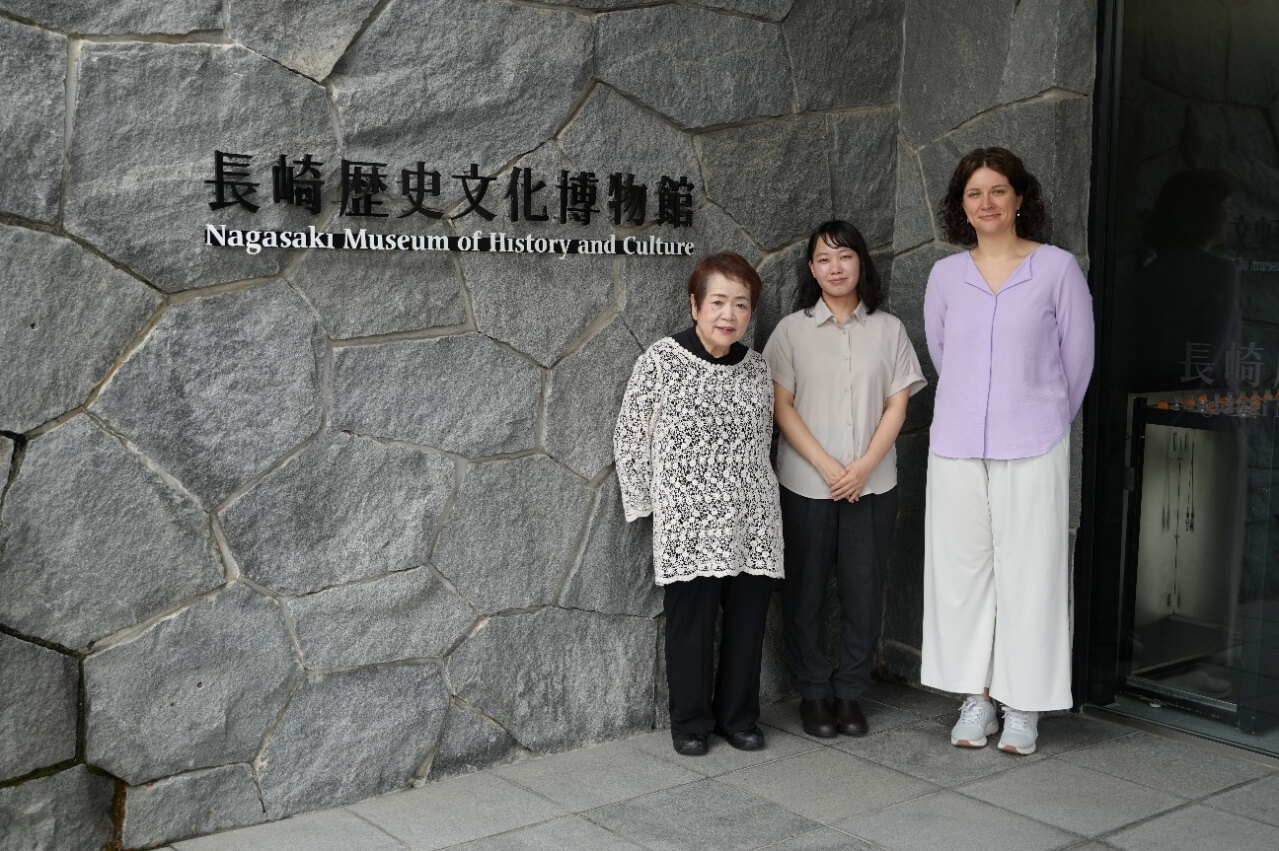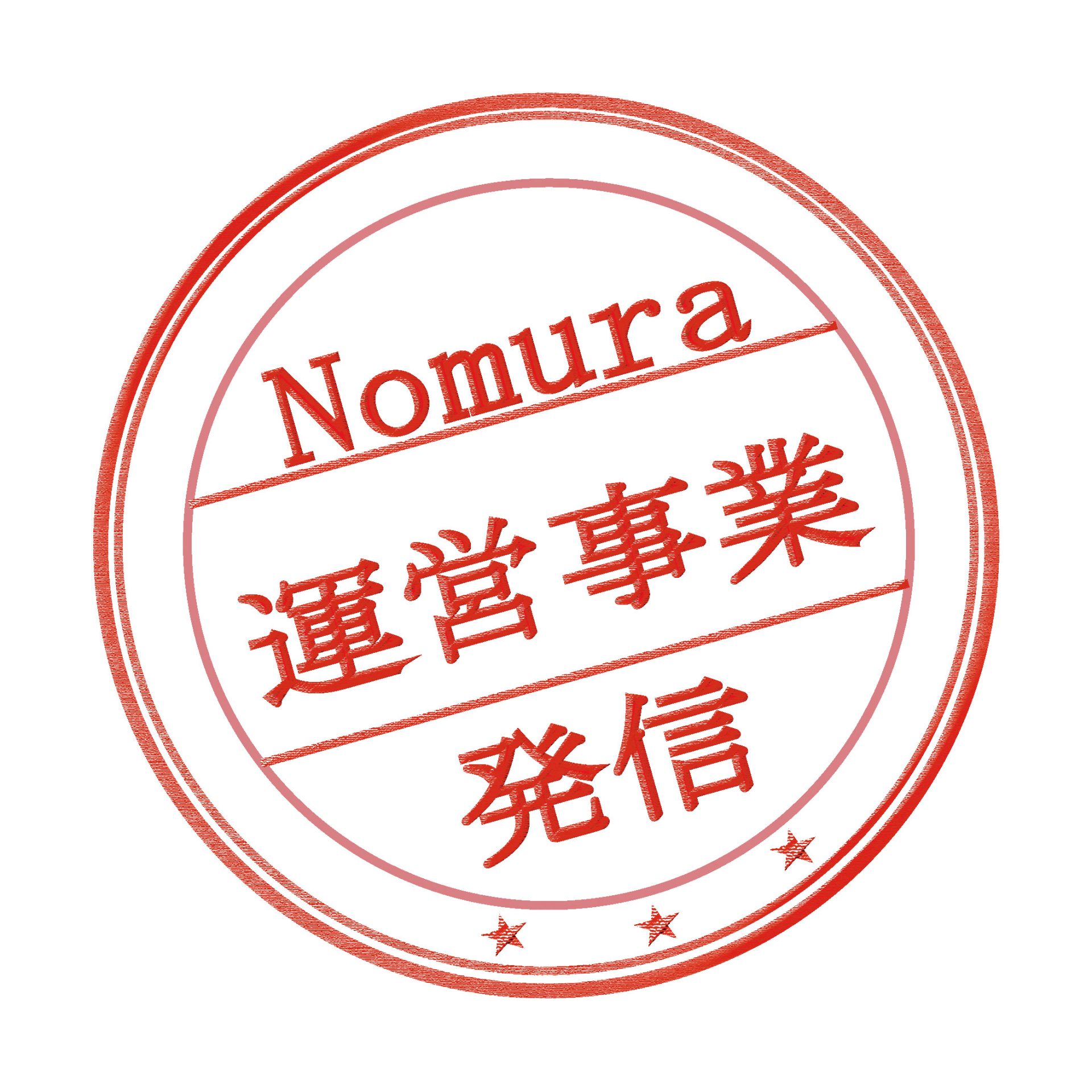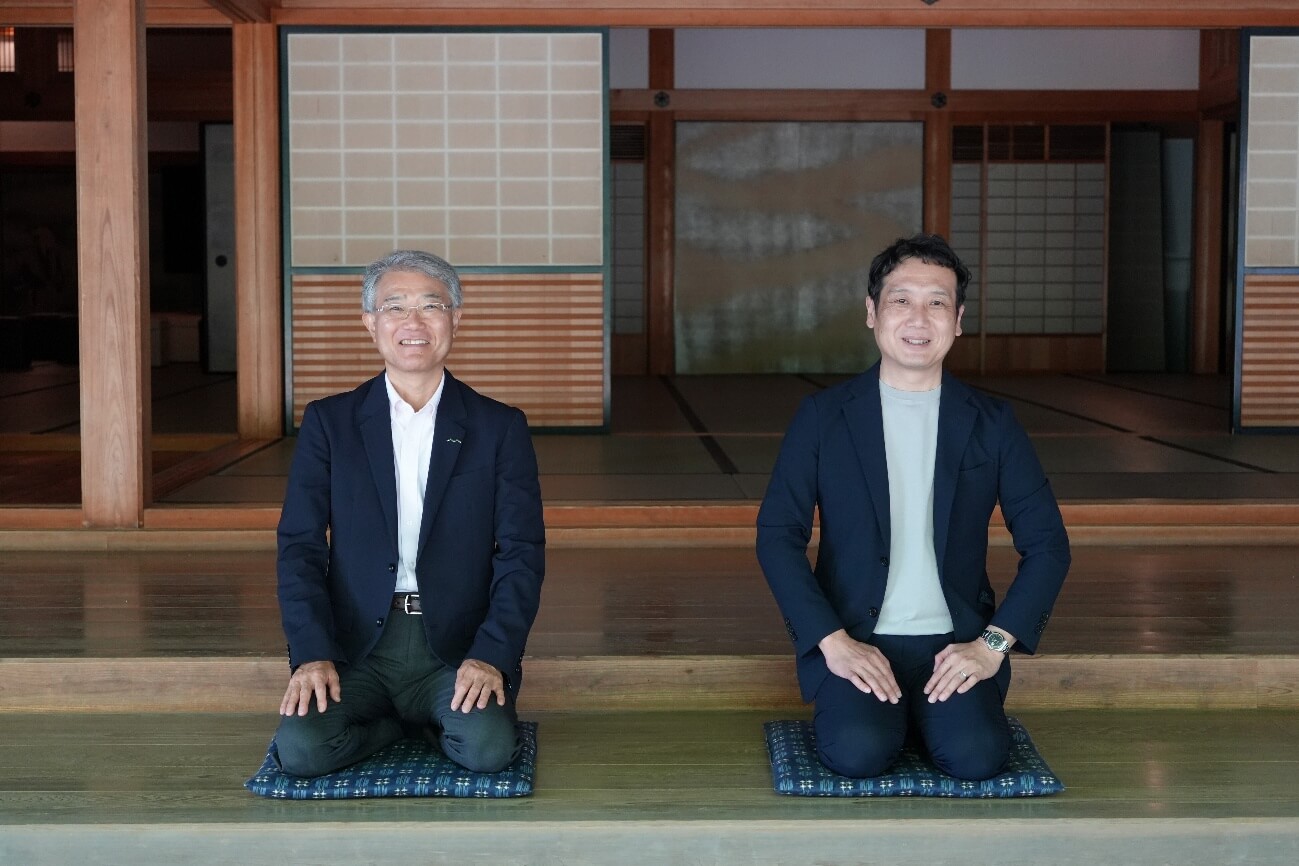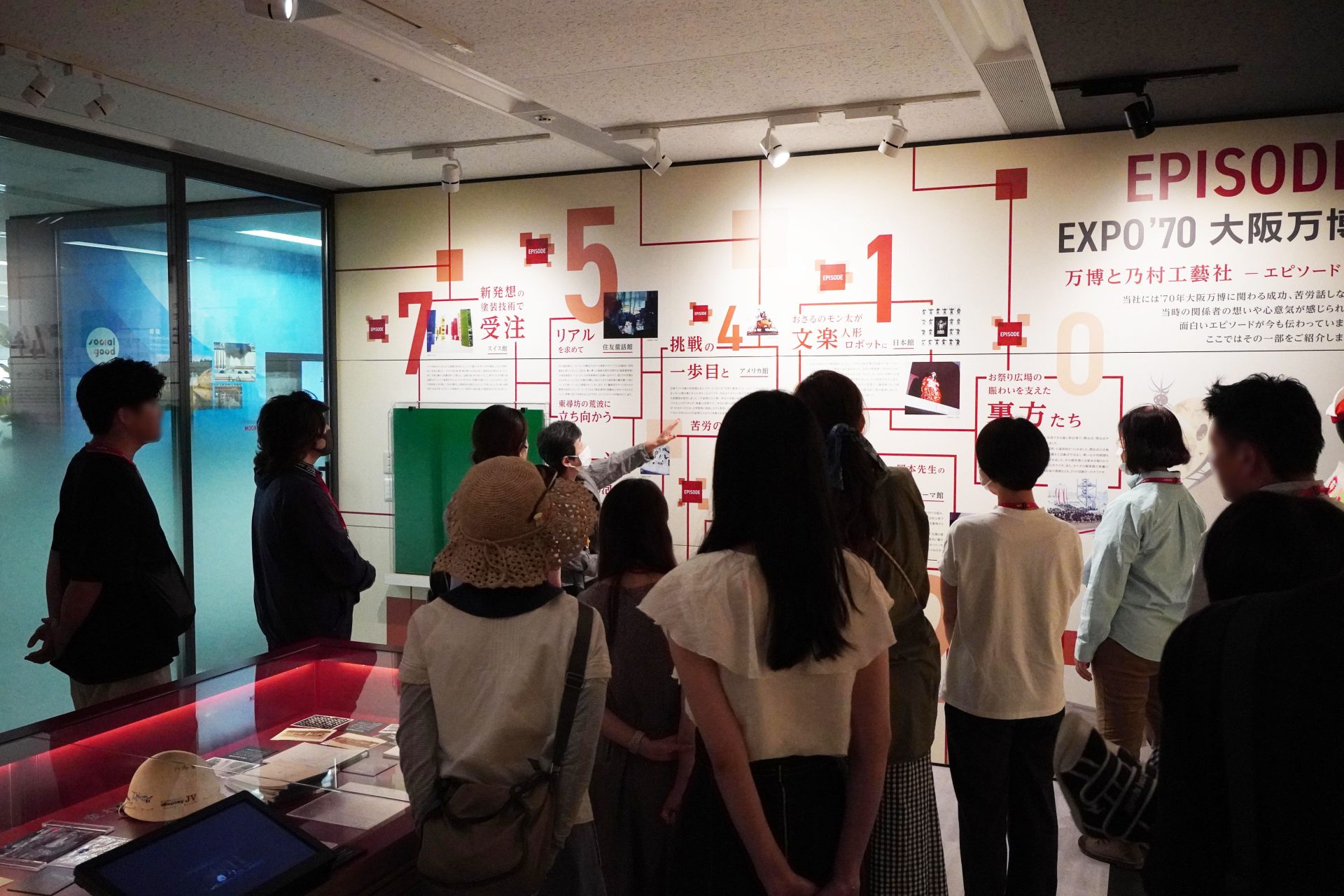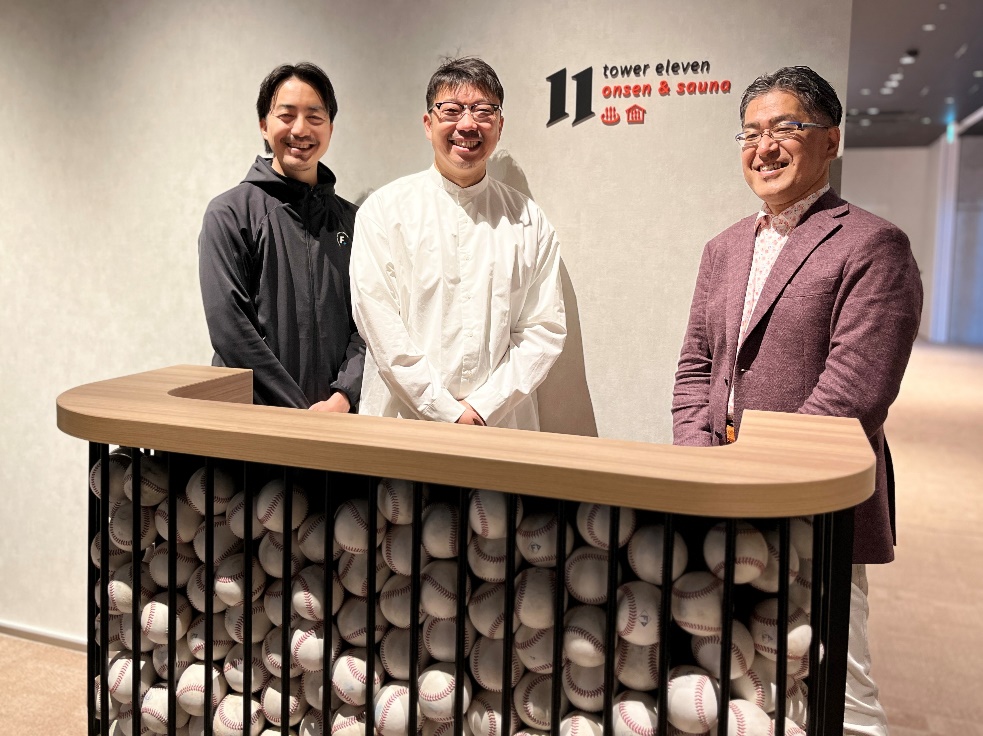- text and edit by
- 梶村 直美
千葉県北西部を供給エリアとした都市ガス事業を主に展開する京葉瓦斯株式会社(以下京葉ガス)が、2021年8月にショールームをコミュニティスペースとしてリニューアル開業した「KeiyoGAS Community Terrace(愛称 てらす)」。「こどもと、おとなと、まちを照らす。」をコンセプトに、地域の人々の暮らしや活動をより豊かにすることを目指し、シェアキッチンやアトリエなどを有した施設へと生まれ変わりました。編み物をしながらお喋りをするママ友たちや、一人でテレワークする人など、開業からわずか数か月で街の暮らしの一部になりつつあります。本記事を担当する梶村は、当施設の立ち上げから開業までのビジョンやコンセプトづくり、オープン後には運営の支援を行っています。
 写真:KeiyoGAS Community Terrace(愛称 てらす)
写真:KeiyoGAS Community Terrace(愛称 てらす)
KeiyoGAS Community Terrace(愛称 てらす)
〒272-0023 千葉県市川市本八幡3丁目14-1
営業時間:10:00〜17:00(年末年始他除く)
Instagramアカウント:@keiyogas_terrace
地域へ開き、地域と関わる企業施設づくりから
企業ブランディングの可能性を考える
コロナ禍を経て見直されつつある企業施設のあり方や企業と地域との関わり方。地域住民との共創を通じて新たな企業施設に挑戦する京葉ガス営業企画部販売企画グループてらすチームリーダー 鈴木祐介さん、「てらす」の運営を担う非営利型株式会社Polaris(以下Polaris)代表取締役 大槻昌美さんを迎え、プロジェクトを担当した乃村工藝社のメンバー、古賀紗弥佳(空間デザイン)、矢野凌雅(プロジェクトマネジメント)とともにプロジェクトを振り返り、地域との関わりを通して見えてきた企業ブランディングの可能性を探っていきます。
 (写真左から)梶村直美(プランナー)、京葉ガス 鈴木祐介さん、古賀紗弥佳(デザイナー)、Polaris 大槻昌美さん、矢野凌雅(プロジェクトリーダー)
(写真左から)梶村直美(プランナー)、京葉ガス 鈴木祐介さん、古賀紗弥佳(デザイナー)、Polaris 大槻昌美さん、矢野凌雅(プロジェクトリーダー)
明日の暮らしづくりを目指して
地域の皆さんとの接点を増やす場づくりを
梶村:
以前と比べ、情報のあり方が大きく変わる中で、企業と生活者の関わり方が一変しています。さらに、コロナ禍を経て、企業も生活者も地域(地元)に対する価値観が大きく変化しています。これからの企業コミュニケーションにおいて、「地域」という視点が生活者とのエンゲージメントを高める上でヒントになるのではと思っています。
そんな中、長年、地域に密着した事業を展開されている京葉ガスさんとご一緒する機会をいただき、今回のショールーム(以下SR)リニューアルにあたっては「地域」とより関わろうという想いで取り組まれたい、とのご要望がありました。まずは、京葉ガスのご紹介とSRリニューアルの経緯を教えてください。
鈴木:
京葉ガスは、千葉県北西部を中心に都市ガスを供給しており、2019年にはグループ会社である京和ガス株式会社とあわせてお客さま件数100万件を達成しました。エリアは限定的ですが、ベッドタウンということもあり、これだけのお客さまにガスを供給しています。そして、2021年にはガスやエネルギーだけではなく、お客さまの生活全般の快適さをご提供する企業を目指しリブランディングを図りました。生活関連サービスの一つとして、ハウスクリーニング事業(「京葉ガスのハウスクリーニング」)を開始しています。
京葉ガス HP
 京葉瓦斯株式会社営業企画部販売企画グループてらすチームリーダー 鈴木祐介さん
京葉瓦斯株式会社営業企画部販売企画グループてらすチームリーダー 鈴木祐介さん
鈴木:
以前のSRは2007年に大規模なリニューアルを図りました。オール電化への対抗策として、ガス機器の良さを体験・体感していただくことを主な目的とし、ガス機器やリフォーム商材を中心とした展示をしていました。一方で、展示を毎年入れ替えるのには相応の体力がいりましたし、リフォーム営業や機器販売においては、SR以外のチャネルも多く志向するようになる等、営業手法が多様化してきていました。こんな課題を抱えながらSR運営をするなかSR自体のあり方を模索していましたが、リブランディングを機にリニューアルをする運びとなりました。
梶村:
リニューアル方針を決める上でベンチマークなどはしたのですか。
鈴木:
自社と同規模の都市ガス事業者のSRにおける取組みを見ていると、地域の人々のより近いところで様々なサービスを提供されていて、地域への根差しかたについて学ぶべきところが多くありました。また、世の中で流行っている施設は大概行きましたね。やはり、モノではなくコトが重要であると気づかされましたね。
そこで、地域の人々が日常的に通っていただけるように、1階は料理や食生活を、2階はカルチャー的要素を通じた親子の居場所をテーマにゾーニングを検討していました。
矢野:
オリエンテーションの際には「公民館以上、ホール未満」なんてキーワードが出されていましたね。
鈴木:
営利活動ができない公民館、そして、用途や規模が限定的なホール。民間企業が運営するという強みを活かし、その間を上手くついた小回りの利く施設にしたかったのです。
立場を越えたフラットな関係性が
これからの場づくりやブランディングには大切
梶村:
地域の方々が日常的に使える施設にしたいという強い想いがリニューアル方針に込められていましたね。そんな方針を受けて、乃村工藝社メンバーはどうでしたか。
矢野:
最初の印象は、かなり振り切ったなという驚きとともに不安もありましたね。ただ、鈴木さんたちからは一緒に汗をかいていこうとコメントもいただいたので、我々も全力で振り切った提案をしていこうという想いがもてました。
古賀:
コロナ禍を経て、以前よりも多くの企業が地域に目を向けていますよね。自社の商品や事業をどうアピールするかから、SDGsなど俯瞰的視野へシフトしてきている中で、私は素直に受け止められました。ただ、どうやって運営していくのかと不安もありましたね。開業後も含めたプロセスが大きな課題だなと。
 (写真左から)古賀紗弥佳(デザイナー)、矢野凌雅(プロジェクトリーダー)
(写真左から)古賀紗弥佳(デザイナー)、矢野凌雅(プロジェクトリーダー)
梶村:
そうですね。私はリニューアル方針や京葉ガスのブランディング活動を拝見し、人肌感のある企業だと興味深く捉えました。そして、地域のポテンシャルを探るために地域で実際にフィールドワークをし、面白い取組みをしている方々とお話しさせていただきました。そこから、市民活動が非常に活発な特徴をもつエリアだなと感じました。
そんな地域のエネルギーを新しいSR運営に活かせないか、そして市民同士が集い繋がることで街での暮らしをより豊かにしていけないか。「三方良し」の場づくりが、京葉ガスらしいブランディングに貢献できるのではないかと新しい施設像を描いていきました。
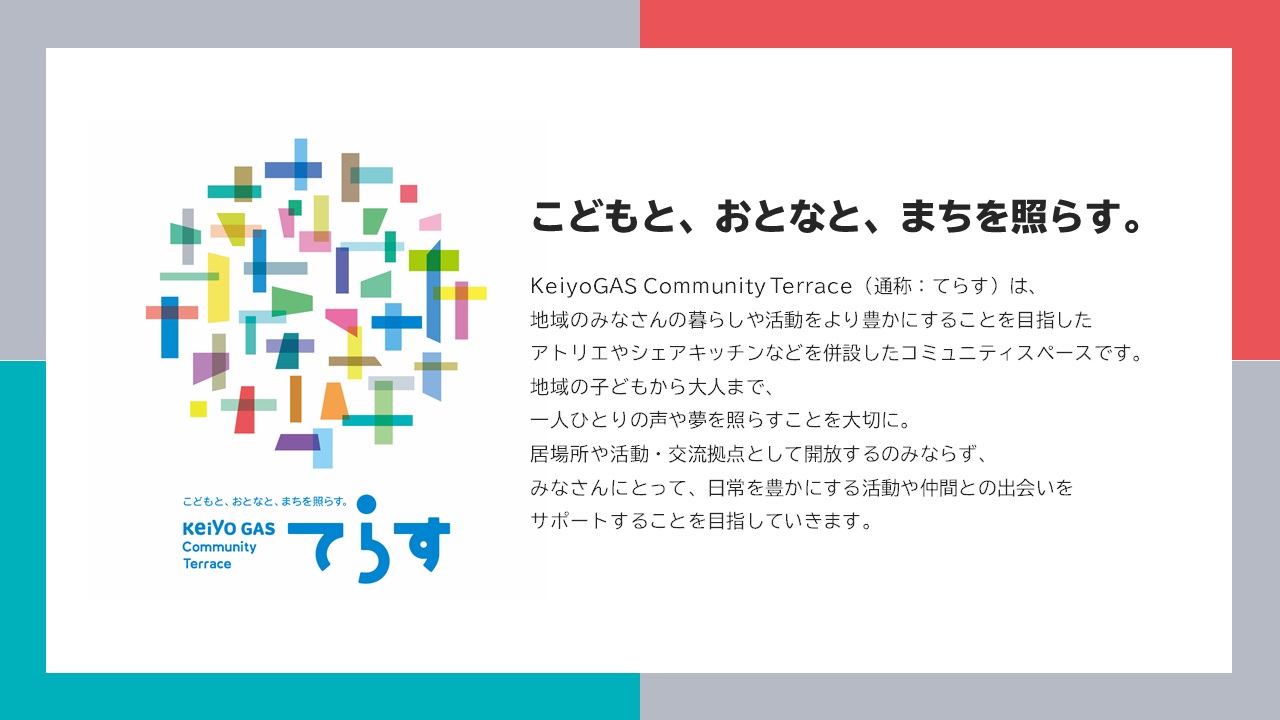 施設コンセプト
施設コンセプト
梶村:
そして、今回は地域の方々をどんどん巻き込みながら場づくりをしていくプロセスや人々の関わり方をデザインしていくことが、新しい施設には重要だと考えていきました。いわゆる、コミュニティデザインですね。
鈴木:
大胆なリニューアル方針に踏み切ったものの、正直に言うと私たちも不安でした。そんな中、乃村工藝社から我々の予想以上の提案を受けることができました。また、さまざまなアプローチからの提案もあったからこそ決断することができました。
梶村:
良い意味で弊社に委ねて頂けたことで、我々も遊び心をもって積極的にチャレンジすることができました。企業施設となると、サービスを提供する企業とサービスを享受するユーザーという関係性が当たり前です。ただ、ここでは利用者はユーザーでもありパートナーにもなりうると定義し、地域で活動する市民の方々に、この場づくりの仲間になっていただけないかと声をかけさせていただきました。座談会での市民の皆さんとの関係性の構築をはじめ、このような市民を巻き込んだプロセス設計は我々にとっても大きなチャレンジでしたね。
矢野:
プロジェクトリーダーの立場としては、ニーズを聞くことを大切にするため、このプロセスを重視しました。我々が仮説をもって空間機能をデザインしても机上の空論でしかないので、地域の人々が求めていることを探っていくべきだなと。ただ、聞きすぎても良くないが、線を引くのも違う。このニーズを聞いて検証をしていくプロセスのデザインは悩ましかったです。
ニーズ探索にあたっては、運営会社であるPolarisからの企画提案もあり、ヒアリングではなく座談会といった形式をとりました。地域で活動する3つの団体から数名と、弊社メンバーはもちろん京葉ガスの皆さんも参加していただきました。我々が聞かせてくださいというスタンスではなく、ユーザー側の立場に立って対話することができました。ニーズとしては様々ありつつも、その本質を拾いやすかったように感じています。これが、施設完成の前に踏めたことが、大きなポイントだったと思います。
 写真:座談会の様子
写真:座談会の様子
みんなで育てる場づくりを通して
企業とお客さまとを越えた関係性を
梶村:
この地域の人々との関係構築にあたっては、施設の運営を担当してくださったPolarisの存在が大きかったです。では、Polarisのご紹介と当プロジェクトに関わっての感想をお願いします。
大槻:
Polarisでは、「未来におけるあたりまえのはたらき方をつくる」ことをミッションとしており、コミュニティづくりを通じて地域で働くことをサポートしています。仕事を通した関係づくりや、仕事から暮らしをより豊かにすることを目指して活動しています。事業は、コミュニティ運営に加え、マンション販売時に地域情報を伝える「くらしのくうき」や、中小企業のバックオフィス業務、働くことをテーマに共に学び合うリベラルアーツなどに取組んでいます。
Polaris HP
 非営利型株式会社Polaris代表取締役 大槻昌美さん
非営利型株式会社Polaris代表取締役 大槻昌美さん
大槻:
一般的には施設が出来上がった後、運営から依頼されることが通例です。その前段階から、地域の人々と対話できたことで、私たちも当事者となって関わりしろが持てる場となりました。それは大きなポイントでしたね。スタッフ側も、地域の人々にとってもスムーズな施設運営が可能になったかと思います。
鈴木さんたちの熱い想いもそうですが、計画の前段階から地域に入り込んで、地域の人々の声を聞きに行っている梶村さんの姿勢にも本気度を感じてました。この人たち、面白そうだなと。
梶村:
計画段階から地域の人々と会話してみて可能性を感じていました。大槻さんは座談会で地域の人々と対話してみて、いかがでしたか。
大槻:
市川市内で市民活動に取組まれている方々って、皆さん既にネットワークがあり仲が良いんです。座談会の前日も、皆さんで会っていたようで。いざ、「てらす」を通して街のみんなにどうしたいかというテーマで話してみると、既に知っているはずの参加者たちが、団体の枠を超えて個人の想いを初めて聞けたと驚きと新鮮さを感じていたようです。
梶村:
座談会への参加にあたっては、団体の代表としてではなく、街で住まい暮らす一人の生活者として発言いただくことで、皆さんが素直に街と向き合える良い機会になったのでしょうね。
この座談会に参加いただいた市民団体を「てらす」ではサポーターとお呼びしています。サポーターの皆さんとの関わり方は、事業者側としていかがですか。
鈴木:
企業でも個人でもない皆さんとの関わり方やキャラクターはまだ定まっていないのが正直なところです。サポーターの皆さんとともに「てらす」を一緒に創っていこうという場面に誘っていくことにおいても、まだまだ課題が多くありますね。
大槻:
よく、コミュニティを「つくる」と言われるが、コミュニティは作ろうと思ってつくれるものではないんです。関わる人によって、どちらに転ぶか分からない、「育む」場なんです。育むにはやはり時間がかかるため、企業として数年単位での経変変化にどこまで向き合えるか、これからが関わるみなさんと共にする挑戦になると思います。

梶村:
「てらす」利用にあたっては会員制度を設けています。この会員になるためには、施設ツアーへの参加と理念への共感が求められるという、ひと手間をかけるようにしています。それでも会員は100人を超えたようですね。これからコミュニティを育てていくことに対する想いを聞かせてください。
鈴木:
利用者の声から「ゆっくり利用」という枠を新たに設けさせていただきました。すると、想定しなかった利用シーンも見られるようになりました。ルールも必要ですが、ニーズに合わせて柔軟に対応することで、地域に寄り添う姿勢を大切にしていきたいと思います。大変ですが、地域の人々の声に耳を傾けていくことを大切にすることで、地域とともに育つ施設づくりに取り組んでいきたいと思っています。
「てらす」プロジェクトを通して、乃村メンバーからひと言
古賀:
今まではオープンがピークの施設がほとんどでした。時間がたつことでより良くなっていく施設はなかなか経験がなかったので可能性を感じています。空間設計では、ある程度、使われ方の仮説を立てながらも手探り状態で進めていきました。それが良く転じて、結果としてはどこで誰もが何をやっても良い空間づくりができました。
また、自社を主語にせず、地域の方々の利用に寄り添う京葉ガスの姿勢に本気度を感じていたので、デザイナーとしても安心してそれに応えることができました。企業色を押し出さない方針も、インクルーシブでニュートラルな世界感がつくれて良い結果となりました。

矢野:
日々の利用シーンを垣間見ると、地域の一部になり始めているのを感じています。サポーターの皆さんはじめ、地域の生活をより良くするためのアイデアが様々な人と出し合える関係性や仕組みづくりもできていくと良いですね。
フレキシブルな空間をつくろうという方針はあっても、進める中で企業としての条件が足されていくことが大概です。今回は、京葉ガスの皆さんの強い想いのもと、我々の提案に一つひとつ受けとめて真摯に返してくださり、結果としてより良い空間ができ、マネジメントの立場からも楽しかったです。

梶村:
フレキシブルな空間をつくろうとなっても、誰がどう運用していくのかが見えないとデッドスペースでしかありません。施設として持続的に成長し続ける仕組みがあってこそ、フレキシブルが活きてくるものです。また、そこにはユーザーたちが参加できる関わりしろを用意することで、施設が自分ゴトとなり愛着が生まれ、それが自走していくためのエネルギーとなっていくのだと思います。
この関わりしろづくりの一つとして、サポーターや会員のみなさんと地域の暮らしを考える機会を「てらす」の定番プログラムとして設けています。これをきっかけに、良いサイクルが施設のみならず地域にも拡がっていくことを期待しています。
 写真:てらすでの定番プログラム風景
写真:てらすでの定番プログラム風景
てらすでのイベントを通じて見えてくる、地域とともに育つ施設づくりのポイントをこちらの記事でご紹介しています。こちらも是非ご覧ください。
企業と地域の新しい関係性「KeiyoGAS Community Terrace(愛称 てらす)」ではぐくむコミュニティ
梶村:
本日はありがとうございました。
この記事は気に入りましたか?
